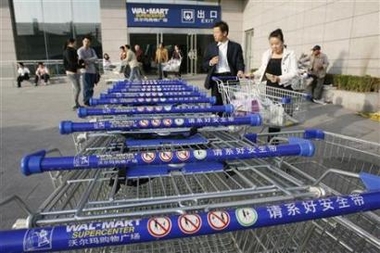Today we all claim victory in knowing our efforts continue to discourage Wal-Mart from bringing their low quality jobs to New York City. The New York Times has learned that Wal-Mart is getting so discouraged that they are writing New York City off...

March 28, 2007
Wal-Mart Chief Writes Off New York
Wal-Mart to New York: fuhgeddaboudit.
Frustrated by a bruising, and so far unsuccessful battle to open its first discount store in the nation’s largest city, Wal-Mart’s chief executive said yesterday, “I don’t care if we are ever here.”
H. Lee Scott Jr., the chief executive of the nation’s largest retailer, said that trying to conduct business in New York was so expensive — and exasperating — that “I don’t think it’s worth the effort.”
Mr. Scott’s remarks, delivered at a meeting with editors and reporters of The New York Times, amounted to a surprising admission of defeat, given the company’s vigorous efforts to crack into urban markets and expand beyond its suburban base in much of the country. In recent years, Wal-Mart has encountered stout resistance to its plans to enter America’s bigger cities, which stand as its last domestic frontier.
Much of the opposition to Wal-Mart in cities like New York is led by unions. Organized labor, fearing that the retailer’s low prices and modest wages will undercut unionized stores, have built anti-Wal-Mart alliances with Democratic members of city councils.
Yesterday, labor leaders, upon learning of Wal-Mart’s apparent retreat from New York — or at the very least Manhattan — returned Mr. Scott’s sentiment.
“We don’t care if they’re never here,” said Ed Ott, executive director of the New York City Central Labor Council. “We don’t miss them. We have great supermarkets and great retail outlets in New York. We don’t need Wal-Mart.”
For Wal-Mart, New York City has long loomed as a tantalizing prize — the home of more than eight million consumers and attention-grabbing stores for just about every major retailer in the country.
But Wal-Mart, a cost-minded retailer known for its dowdy merchandise, and New York, a city of excesses known for cutting-edge style, have long had an uneasy relationship.
Wal-Mart executives have argued that low prices would be the universal language that bridged the gap. So far, they have not.
During the questioning, Mr. Scott repeatedly referred to New York, but after the meeting a Wal-Mart spokeswoman, Mona Williams, called to say that Mr. Scott was referring to only Manhattan, not the entire city.
Wal-Mart, which has nearly 4,000 stores in the United States, has sought to open stores in Rego Park, Queens, and in Staten Island, but both plans fell through in the face of intense union, community and political opposition.
Mr. Scott said yesterday that the opposition to Wal-Mart in New York, Chicago, Cleveland, Los Angeles and other cities had a common thread: “The glue is the unions.”
Despite setbacks in each of these cities, Wal-Mart has had success in urban areas. In Chicago, for example, Wal-Mart opened a store last year that attracted thousands of job applicants and has, Mr. Scott said, performed better than expected.
He said that Wal-Mart executives have lobbied for a store in New York, but he said he remains unconvinced. “It’s too hard to make money here,” he said.
Late yesterday, Ms. Williams sought to amend Mr. Scott’s remarks.
“Entering New York has been difficult, but not something we rule out,” she said in an interview. “Lee said he personally didn’t care if we built stores there or not. It might be more trouble than it’s worth, but that he would leave that up to the real estate group that makes these decisions.”
As he does in many public appearances, Mr. Scott was quick yesterday to talk up the chief potential benefit of a Wal-Mart in New York City, particularly for its many struggling residents with modest incomes: lower prices because of the chain’s vast purchasing power and highly efficient distribution system.
Surveys have repeatedly shown that Wal-Mart’s grocery prices are typically 10 to 30 percent lower than those of its competitors.
But labor leaders assert that while Wal-Mart’s prices are low, its wages and health benefits are often so skimpy that they leave many workers below the poverty line and pressure competitors to reduce pay and benefits.
“We don’t like how they do business,” Mr. Ott, the New York union official, said.
But as Mr. Scott sees it, there is another reason Wal-Mart has such a hard time making inroads into some of the nation’s biggest enclaves. Speaking about what he sees as snobbish elites in New York and across the country, Mr. Scott added, “You have people who are just better than us and don’t want a Wal-Mart in their community.”



![[Slippery Footing]](http://online.wsj.com/public/resources/images/NA-AN489_WWALMA_20070720191454.gif)


















